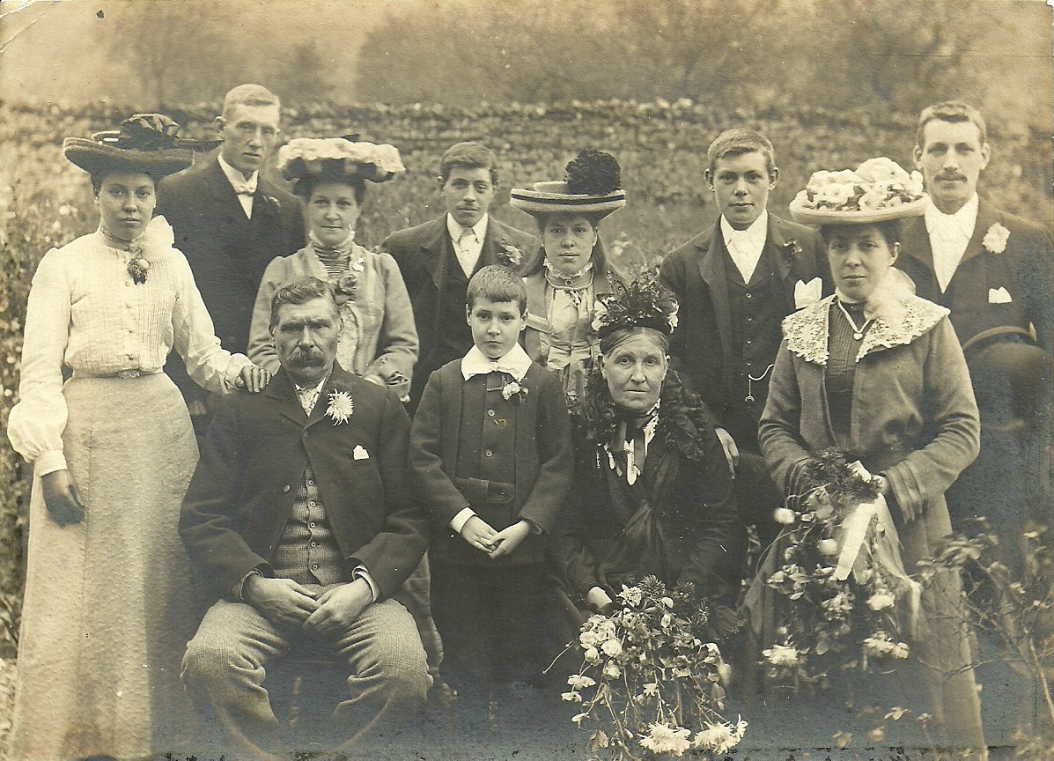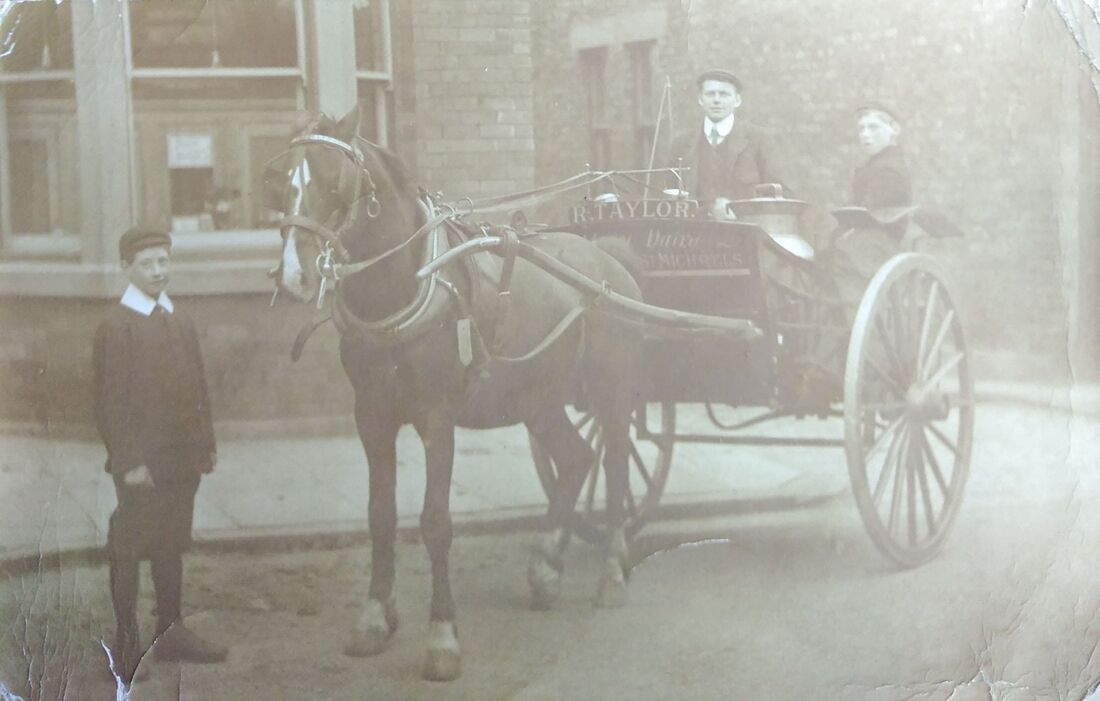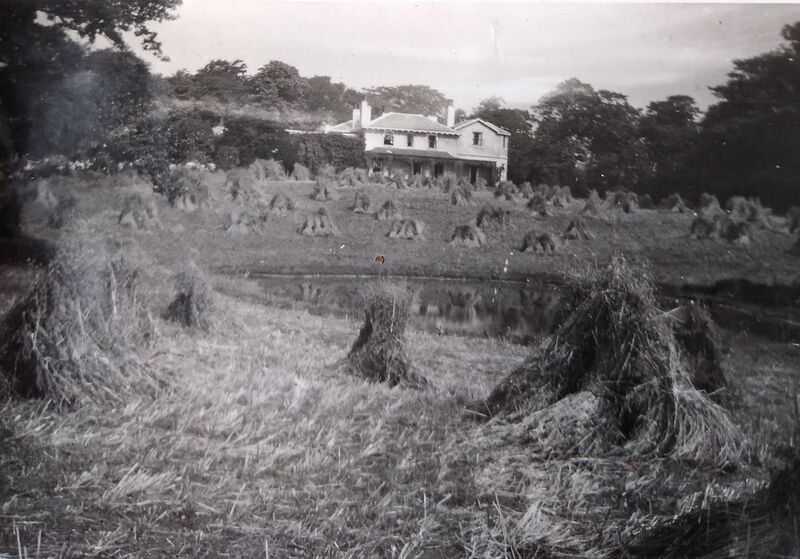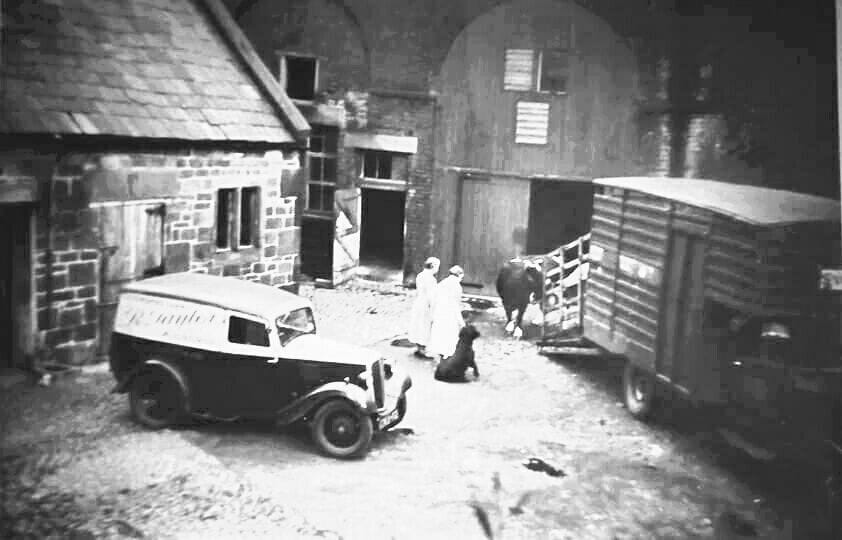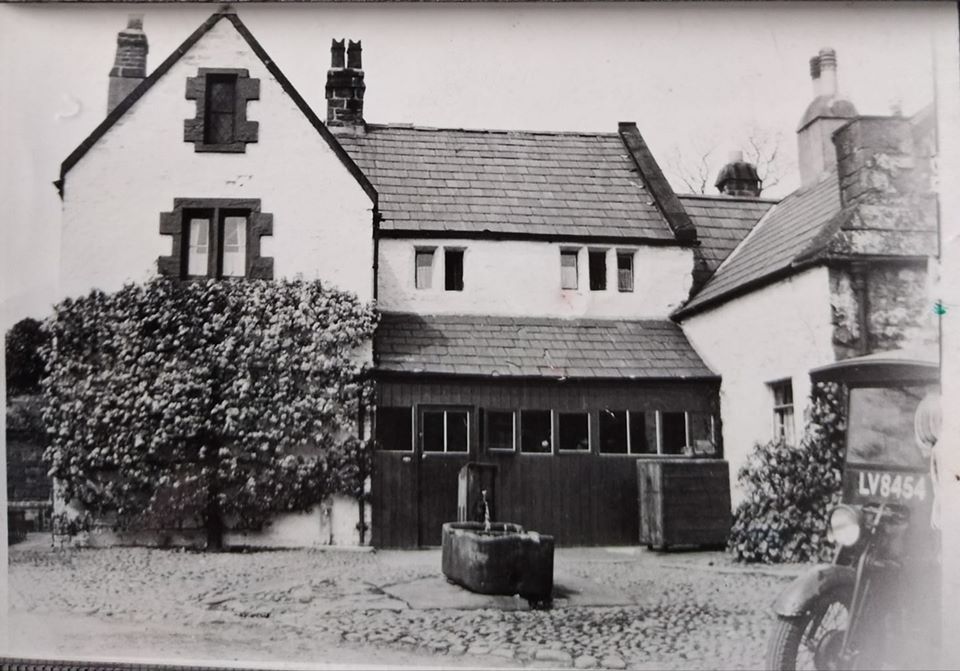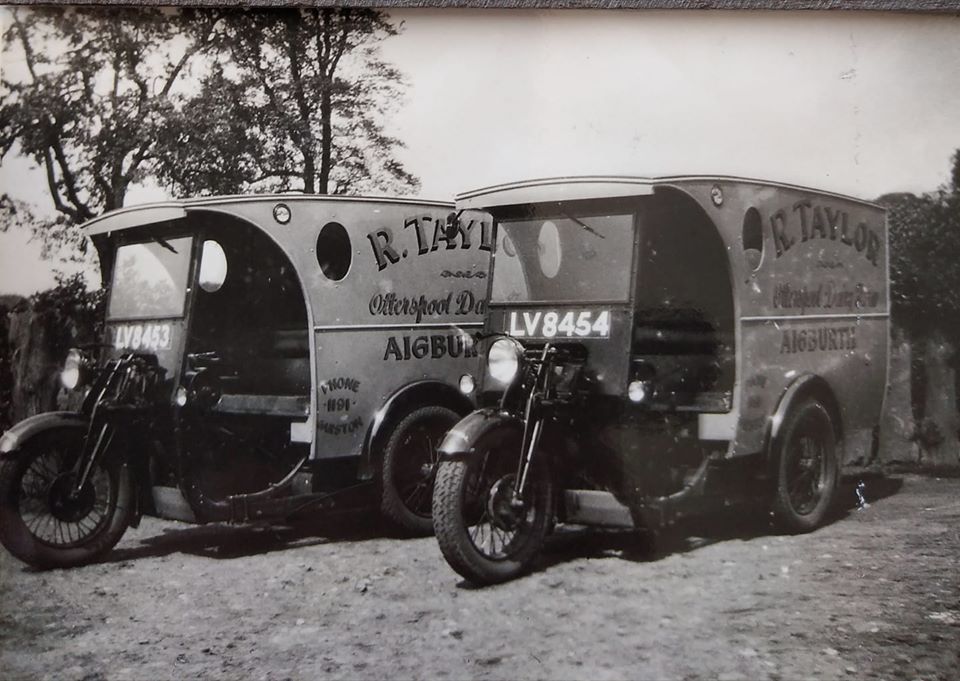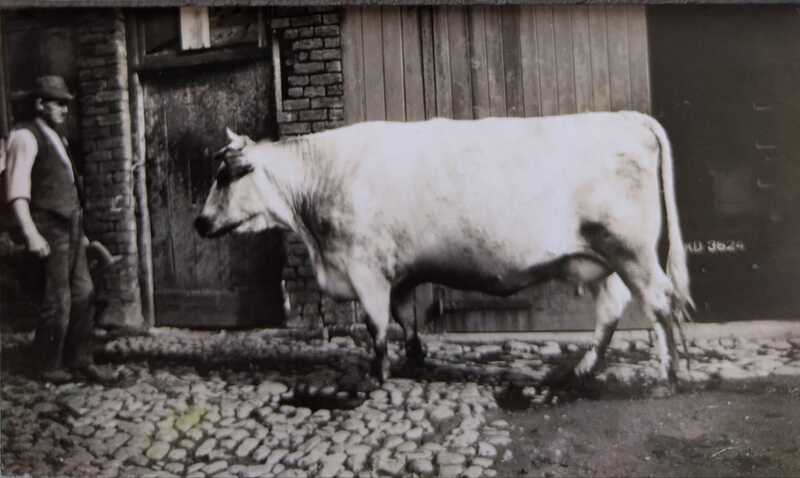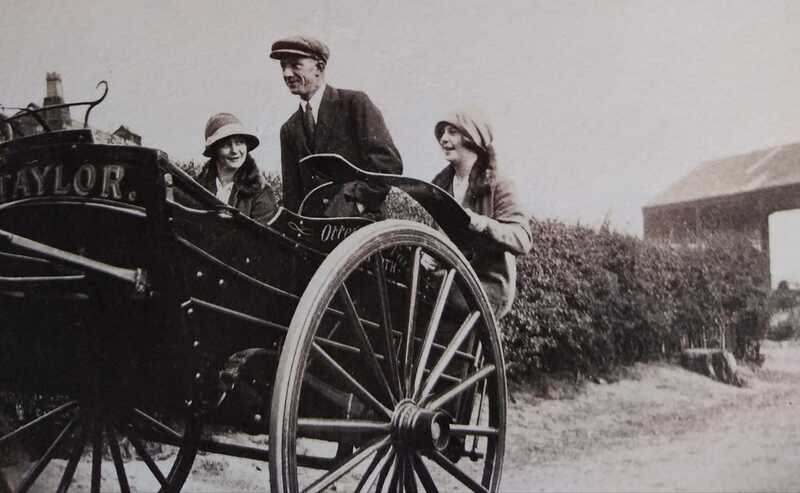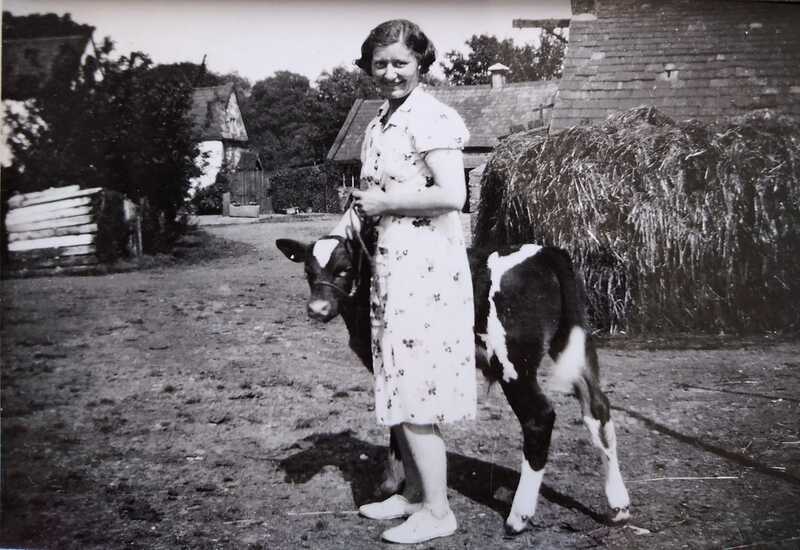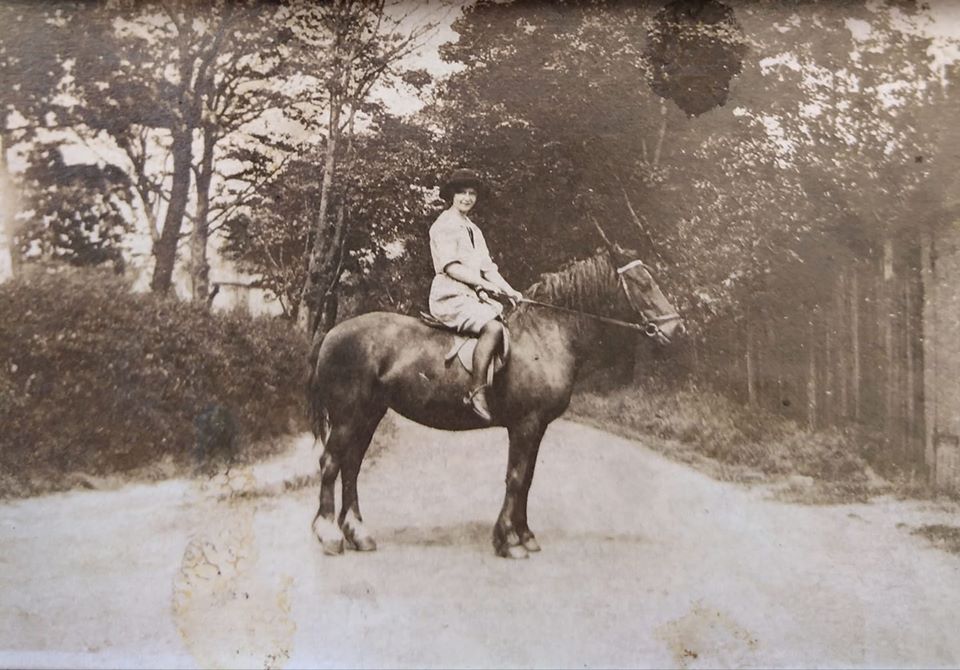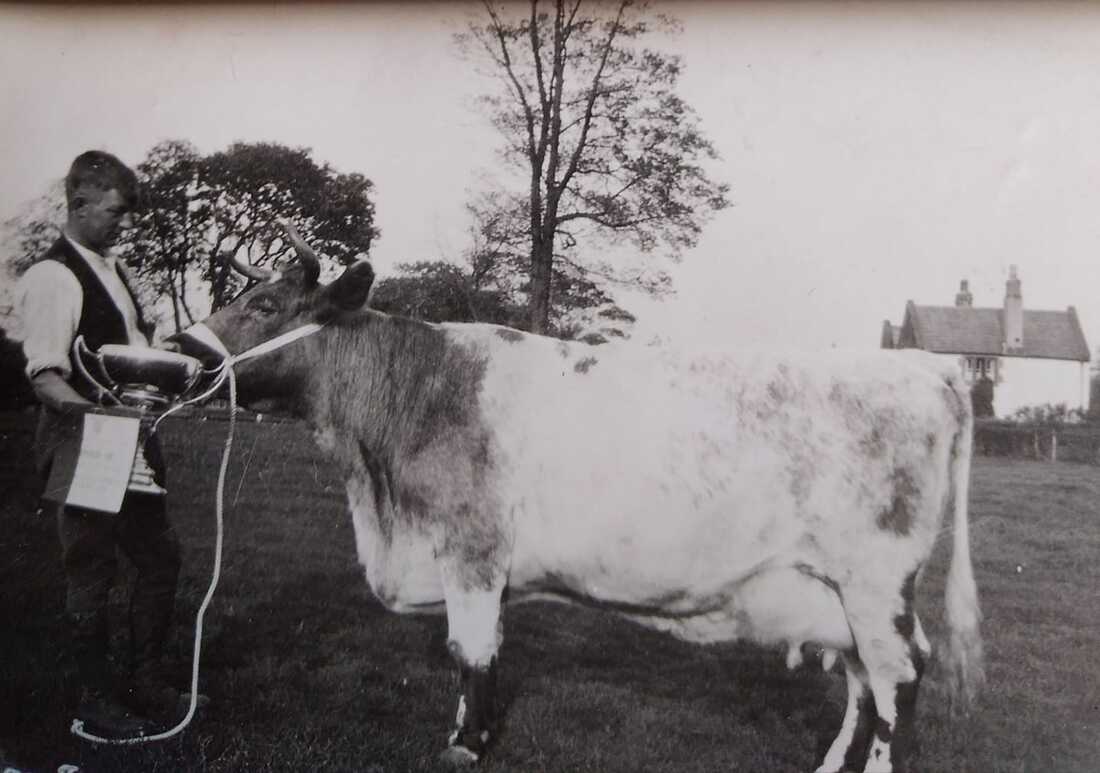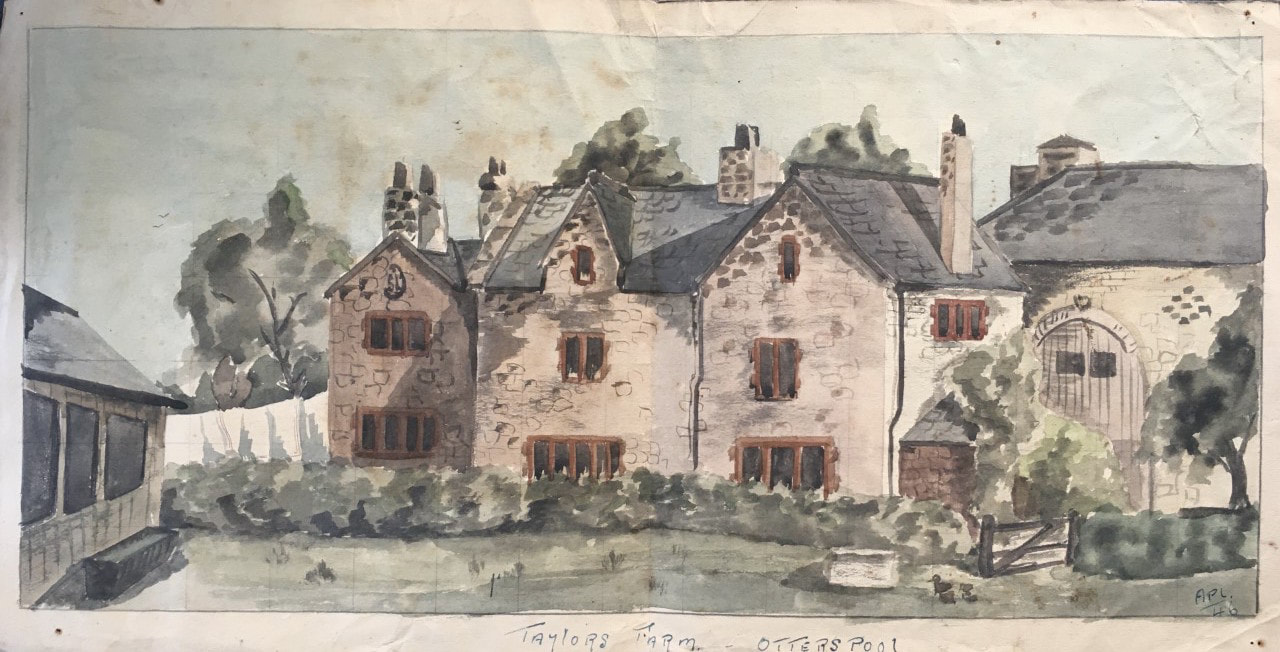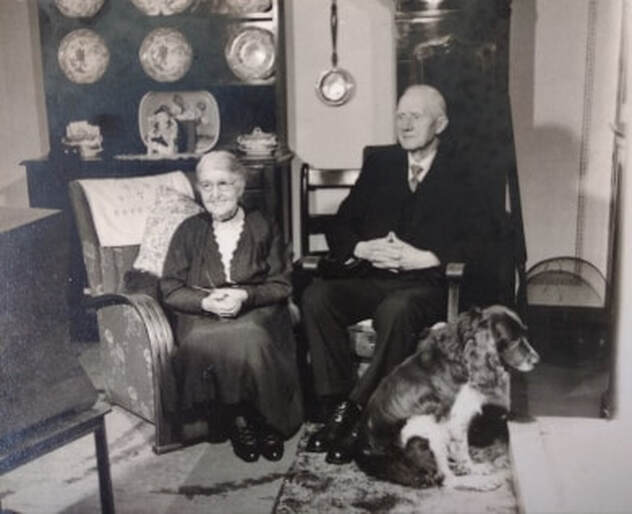It was a lovely coincidence that I received information from two quite separate sources, which referred to the same cowkeeping address in Liverpool. David Smail’s research into the Taylor branch of his family tree has thrown up some unusual anecdotes, whilst amongst her family records, Vera Haydock discovered a newspaper clipping about a 14-year-old Milk Girl. Both of these refer to a dairy business based at 3 Church Road, St Michael's Hamlet - in the Aigburth district of Liverpool – and together give a fascinating glimpse into the cowkeeping way of life in early-1900s Liverpool.
A few years after I posted the original article I was contacted by Kate Thexton, who had attended one of my talks in Sedbergh. Kate is the great-granddaughter of Richard Taylor. She was working her way through a large box of old family photos and was quite generously posting these on-line. I am most grateful to Kate for allowing me to include some of these wonderful photos here.
A few years after I posted the original article I was contacted by Kate Thexton, who had attended one of my talks in Sedbergh. Kate is the great-granddaughter of Richard Taylor. She was working her way through a large box of old family photos and was quite generously posting these on-line. I am most grateful to Kate for allowing me to include some of these wonderful photos here.
The Taylor Family’s Farming Roots
Richard Taylor (b. 1874) was one of nine children of John and Margaret (nee Barnes). The family farm, called Thorphinsty Hall, was 400 acres near Cartmel Fell - located in what was then, northern Lancashire. When John took the tenancy at Thorphinsty he had to borrow from his father-in-law, Anthony Barnes. Anthony was well known and respected as a breeder of Shorthorn cattle. John benefited from his advice and kindness and, no doubt, his bull. There was some good arable land at Thorphinsty, so crops of barley, oats and wheat were grown. John's uncle, Tom, was a corn merchant in Kendal so had no trouble selling his produce. John was lucky to be farming at that time, when mowing machines and steam driven threshing machines became available. Turnips were grown for winter-feed for the cattle.
It was very labour intensive, but with nine children he had the manpower. The girls milked the cows and made it into butter. The men did the mucking out and worked mostly in the fields. Sometimes, Richard and the rest of the boys were given the job of taking cattle to Milnthorpe Station, where there was a weekly market; the cattle left on a train after the sale. The boys drove the cattle along the roads for the ten-mile journey. Father John told them how much they had to make and if they didn't make the price they had to bring the cows back again.
Richard Taylor (b. 1874) was one of nine children of John and Margaret (nee Barnes). The family farm, called Thorphinsty Hall, was 400 acres near Cartmel Fell - located in what was then, northern Lancashire. When John took the tenancy at Thorphinsty he had to borrow from his father-in-law, Anthony Barnes. Anthony was well known and respected as a breeder of Shorthorn cattle. John benefited from his advice and kindness and, no doubt, his bull. There was some good arable land at Thorphinsty, so crops of barley, oats and wheat were grown. John's uncle, Tom, was a corn merchant in Kendal so had no trouble selling his produce. John was lucky to be farming at that time, when mowing machines and steam driven threshing machines became available. Turnips were grown for winter-feed for the cattle.
It was very labour intensive, but with nine children he had the manpower. The girls milked the cows and made it into butter. The men did the mucking out and worked mostly in the fields. Sometimes, Richard and the rest of the boys were given the job of taking cattle to Milnthorpe Station, where there was a weekly market; the cattle left on a train after the sale. The boys drove the cattle along the roads for the ten-mile journey. Father John told them how much they had to make and if they didn't make the price they had to bring the cows back again.
In 1902, in Kendal, Richard married Jane Scott (of Witherslack) and they began their married life together at a small farm called The Ashes. By 1906 they'd had three children: Edward (b. 1902), Margery (b. 1904) and Isabel (b.1906). As the farm was not big enough to support them all, Richard looked out for opportunities elsewhere. Someone told him of the life of a cow keeper. There were a lot of them in the various towns and cities of northern England, many of whom originally came from Westmorland.
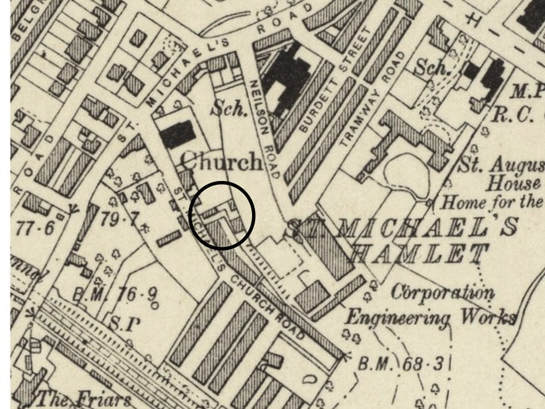 3 Church Road, St Michael's, Aigburth, Liverpool
3 Church Road, St Michael's, Aigburth, Liverpool
The Move to Liverpool
Richard went to Liverpool in search of a suitable opportunity and his search proved to be fruitful. On 19th November 1906, he received a letter from a J. Wolfenden confirming receipt of his deposit for the purchase of a dairy business in the south of Liverpool. It seemed a risky venture to his wife, Jane, and her family, but the deal was done and they set off for the big City. They moved into a property at 3 CHURCH ROAD, St Michael’s Hamlet, in the Aigburth district of Liverpool. This was not a farm but a purpose-built Dairy; there was a yard and shippon to the rear, but no fields for the cows. Although the property had previously been owned by cowkeeper JAMES HANSON (1901 census), at the time Richard took it over it was known as WOLFENDEN'S MODEL DAIRY. The term 'model' was used to describe any dairy designed, and fitted with the latest equipment, to meet the rigorous public health regulations governing milk production at that time. They were considered to be 'modern' dairies and were often opened up for the public to view. The house came with all mod cons too.
Richard went to Liverpool in search of a suitable opportunity and his search proved to be fruitful. On 19th November 1906, he received a letter from a J. Wolfenden confirming receipt of his deposit for the purchase of a dairy business in the south of Liverpool. It seemed a risky venture to his wife, Jane, and her family, but the deal was done and they set off for the big City. They moved into a property at 3 CHURCH ROAD, St Michael’s Hamlet, in the Aigburth district of Liverpool. This was not a farm but a purpose-built Dairy; there was a yard and shippon to the rear, but no fields for the cows. Although the property had previously been owned by cowkeeper JAMES HANSON (1901 census), at the time Richard took it over it was known as WOLFENDEN'S MODEL DAIRY. The term 'model' was used to describe any dairy designed, and fitted with the latest equipment, to meet the rigorous public health regulations governing milk production at that time. They were considered to be 'modern' dairies and were often opened up for the public to view. The house came with all mod cons too.
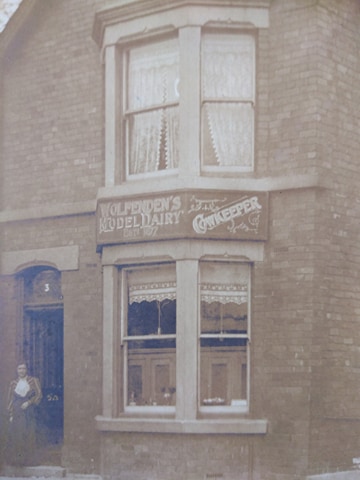 Jane Taylor at 3 Church Road, St Michael's Hamlet, Liverpool - 'Wolfenden's Model Dairy'. (© Kate Thexton 2020)
Jane Taylor at 3 Church Road, St Michael's Hamlet, Liverpool - 'Wolfenden's Model Dairy'. (© Kate Thexton 2020)
Jane was delighted with her new home; it had hot and cold running water, a coal fire and electric lights and a flushing privy. This was paradise for a mother. As for Richard, the cows never left the shippon; they were milked (by hand) three times a day, and the milk delivered three times a day. Fridges hadn't yet been invented, so fresh milk was the norm. When they made the move to Liverpool, Jane was expecting their fourth child and later that year gave birth to a baby daughter, Annie (b. 1907). And a year later they had another girl, Amy Jane (b. 1908).
The family are recorded on the 1911 census, together with their employees:
3 Church Road, St Michael’s, Aigburth, Liverpool
Richard Taylor – Cowkeeper and Dairyman
Jane Taylor – Assisting in the business
Children: Margery May (6), Isabel (5), Annie (4) and Amy Jane (2)
Brother-in-Law: Frederick Scott (32), Farmer's son working on farm, from Witherslack, Westmorland.
Workers in Dairy: Thomas Kinnear (29) from Hesket, Cumberland; Richard William Todd (41) from Walton, Yorks; and Thomas Peers (32) from Liverpool.
Domestic Servant: Mary Jane Polhill (18) from Liverpool.
Some employees had come to Liverpool from the rural areas of Cumberland and Yorkshire, whilst others had been recruited locally. The number of employees on site at the time of the census gives an idea of the scale of operation - it was a very busy dairy! (Edwards absence is thought to be due to him spending time working on his uncle's farm back in Cartmel Fell).
The family are recorded on the 1911 census, together with their employees:
3 Church Road, St Michael’s, Aigburth, Liverpool
Richard Taylor – Cowkeeper and Dairyman
Jane Taylor – Assisting in the business
Children: Margery May (6), Isabel (5), Annie (4) and Amy Jane (2)
Brother-in-Law: Frederick Scott (32), Farmer's son working on farm, from Witherslack, Westmorland.
Workers in Dairy: Thomas Kinnear (29) from Hesket, Cumberland; Richard William Todd (41) from Walton, Yorks; and Thomas Peers (32) from Liverpool.
Domestic Servant: Mary Jane Polhill (18) from Liverpool.
Some employees had come to Liverpool from the rural areas of Cumberland and Yorkshire, whilst others had been recruited locally. The number of employees on site at the time of the census gives an idea of the scale of operation - it was a very busy dairy! (Edwards absence is thought to be due to him spending time working on his uncle's farm back in Cartmel Fell).
Bell Stewardson – a Milk Girl
There was another worker at the dairy, Isabel (Bell) Stewardson, who also originated from Witherslack in Westmorland. Bell had moved back to her hometown just prior to the 1911 census, but her story is told in a newspaper article - ‘A Teenager 100 years ago was ‘in service’ at 14’. The article is based on the research of Bell’s daughter, Mary Irving, who found out about her mother’s teenage years from a collection of old postcards. The text of the article is reproduced below:
Bell Stewardson – a Milk Girl
There was another worker at the dairy, Isabel (Bell) Stewardson, who also originated from Witherslack in Westmorland. Bell had moved back to her hometown just prior to the 1911 census, but her story is told in a newspaper article - ‘A Teenager 100 years ago was ‘in service’ at 14’. The article is based on the research of Bell’s daughter, Mary Irving, who found out about her mother’s teenage years from a collection of old postcards. The text of the article is reproduced below:
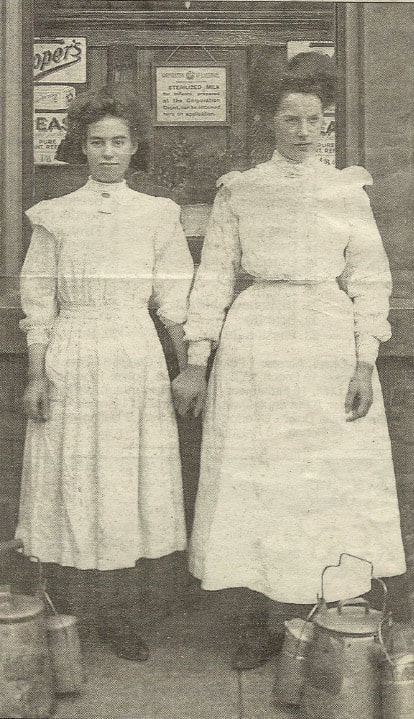 Milk Girl: Bell Stewardson (right), from Witherslack, at work in Liverpool as a milk girl around 1909 (© Vera Haydock 2017)
Milk Girl: Bell Stewardson (right), from Witherslack, at work in Liverpool as a milk girl around 1909 (© Vera Haydock 2017)
Mary Irving, of Sedgwick, has been researching her family history and came across a series of picture postcards, who were a favourite communication in 1900s. From them she has gleaned some idea of the life of her mother, who was a teenager at that time. Much is written about teenagers today, which set me thinking about the life of a young person about 100 years ago. The word teenager had not even been invented then.
My mother, Isabel Stewardson, known as Bell, was born in Witherslack on November 1, 1893, the fourth child in a family of nine. From a small collection of old picture postcards sent by sisters and friends to her at various locations, I have been able to get some idea of what her life was like. The oldest postcard dated 1906 is a card of condolence at the very sad death of a younger sister, aged 10, from meningitis.
By 1907 and early 1908, she was in service working on a farm, High Steneerley, near Lowick in the Coniston area. As she was not 14 years old until November 1907 it is possible she was hired at the Hiring fair at Martinmas on November 11.
She would be classed as a servant girl. Recent statistics released in the 1911 census show that one in every seven of working people at that time was classed as a servant.
Her work would have included all the aspects of cleaning in the house and, on a farm, dairy work and possibly work in the fields.
By July 1908 she was at Rawson’s farm in the Lyth Valley, back near her home. The farmer at that time was called Scott and here Bell received a card saying ‘glad you like’ suggesting she was happy with this move. There was a lighter side to life with references to dances and going to church on Sunday evenings.
Bell’s next move was to a milkhouse in Liverpool, c/o a Mrs Taylor, 3 Church Road, St Michaels, Aigburth. This photograph was taken outside this address. Bell is the taller of the two girls. Bell’s move at this time reflected a trend when many people moved from the north to run or work in dairies, which sold fresh milk to townspeople.
By about 1911, Bell had left Liverpool and was back in Westmorland. The illness of her mother may have been the reason for her returning. Sadly, her mother died in 1911, aged 51, when Bell was only 17, and she later told her children this had been a very great loss.
Bell next worked for a Mrs Bell at Low Greenrigs, Underbarrow, where she seems to have stayed until her marriage, aged 19, in 1913. She went on to have eight children, all of whom survived well into adulthood. Her teenage years had given her a very good training to be a farmer’s wife.
My mother, Isabel Stewardson, known as Bell, was born in Witherslack on November 1, 1893, the fourth child in a family of nine. From a small collection of old picture postcards sent by sisters and friends to her at various locations, I have been able to get some idea of what her life was like. The oldest postcard dated 1906 is a card of condolence at the very sad death of a younger sister, aged 10, from meningitis.
By 1907 and early 1908, she was in service working on a farm, High Steneerley, near Lowick in the Coniston area. As she was not 14 years old until November 1907 it is possible she was hired at the Hiring fair at Martinmas on November 11.
She would be classed as a servant girl. Recent statistics released in the 1911 census show that one in every seven of working people at that time was classed as a servant.
Her work would have included all the aspects of cleaning in the house and, on a farm, dairy work and possibly work in the fields.
By July 1908 she was at Rawson’s farm in the Lyth Valley, back near her home. The farmer at that time was called Scott and here Bell received a card saying ‘glad you like’ suggesting she was happy with this move. There was a lighter side to life with references to dances and going to church on Sunday evenings.
Bell’s next move was to a milkhouse in Liverpool, c/o a Mrs Taylor, 3 Church Road, St Michaels, Aigburth. This photograph was taken outside this address. Bell is the taller of the two girls. Bell’s move at this time reflected a trend when many people moved from the north to run or work in dairies, which sold fresh milk to townspeople.
By about 1911, Bell had left Liverpool and was back in Westmorland. The illness of her mother may have been the reason for her returning. Sadly, her mother died in 1911, aged 51, when Bell was only 17, and she later told her children this had been a very great loss.
Bell next worked for a Mrs Bell at Low Greenrigs, Underbarrow, where she seems to have stayed until her marriage, aged 19, in 1913. She went on to have eight children, all of whom survived well into adulthood. Her teenage years had given her a very good training to be a farmer’s wife.
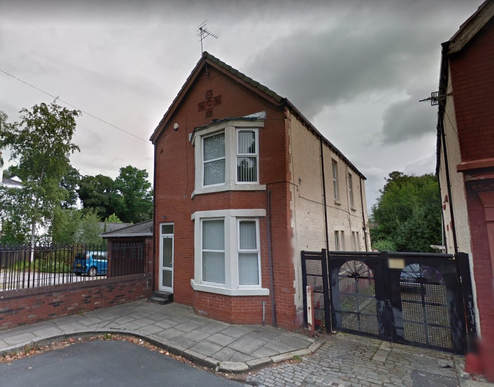 The former dairy at 3 Church Road, St Michael's - 2014 (© 2017 Google)
The former dairy at 3 Church Road, St Michael's - 2014 (© 2017 Google)
Life at 3 Church Road, St Michael’s, Aigburth.
The Taylor sisters were happy at the dairy in Aigburth, until the arrival of their big brother, Eddie. The problem was that Eddie had spent a long time with his uncles, doing the gruesome things that farmers sometimes have to do. But, what he thought was funny, his sisters thought horrific. This problem resolved itself, as their new home was not really a farm, and so there was very little demand for Eddie’s skills.
School holidays saw an exodus of the girls back to Cartmel Fell. The train from Liverpool took them to Lancaster, then another to Grange-over-Sands. Uncle William met them from the station and they were soon at Thorphinsty.
Many Liverpool Cowkeepers were from the South Lakes area, so there was an atmosphere of camaraderie when they met up. This led to the formation of an official organisation — The Liverpool Cowkeepers Association. The association’s social life tended to revolve around public houses, much to Richard’s satisfaction as he enjoyed a pint or two. However, Jane and her fellow cow-wives were excluded from this social activity and were none too pleased about it. In response to this growing disquiet, the men realised they must do something to appease their womenfolk. They came up with the idea of taking their wives on a trip to Switzerland. The ladies liked the idea and were soon enrolling for the trip. As the time for the holiday drew near the numbers increased. Posters were put up in Switzerland to promote the important event and Swiss residents were keen to see how many of these English visitors would arrive. When the time came, the trip was fully booked. As the cowkeepers and their wives arrived in Switzerland on the train they were amazed at the number of people gathered at the station to greet them. The cowkeepers found themselves surrounded by enthusiastic residents. It turned out that there had been a mistake in the translation; the posters that had been put up to advertise the cowkeepers arrival had been worded to welcome — COWBOYS!
The Taylor sisters were happy at the dairy in Aigburth, until the arrival of their big brother, Eddie. The problem was that Eddie had spent a long time with his uncles, doing the gruesome things that farmers sometimes have to do. But, what he thought was funny, his sisters thought horrific. This problem resolved itself, as their new home was not really a farm, and so there was very little demand for Eddie’s skills.
School holidays saw an exodus of the girls back to Cartmel Fell. The train from Liverpool took them to Lancaster, then another to Grange-over-Sands. Uncle William met them from the station and they were soon at Thorphinsty.
Many Liverpool Cowkeepers were from the South Lakes area, so there was an atmosphere of camaraderie when they met up. This led to the formation of an official organisation — The Liverpool Cowkeepers Association. The association’s social life tended to revolve around public houses, much to Richard’s satisfaction as he enjoyed a pint or two. However, Jane and her fellow cow-wives were excluded from this social activity and were none too pleased about it. In response to this growing disquiet, the men realised they must do something to appease their womenfolk. They came up with the idea of taking their wives on a trip to Switzerland. The ladies liked the idea and were soon enrolling for the trip. As the time for the holiday drew near the numbers increased. Posters were put up in Switzerland to promote the important event and Swiss residents were keen to see how many of these English visitors would arrive. When the time came, the trip was fully booked. As the cowkeepers and their wives arrived in Switzerland on the train they were amazed at the number of people gathered at the station to greet them. The cowkeepers found themselves surrounded by enthusiastic residents. It turned out that there had been a mistake in the translation; the posters that had been put up to advertise the cowkeepers arrival had been worded to welcome — COWBOYS!
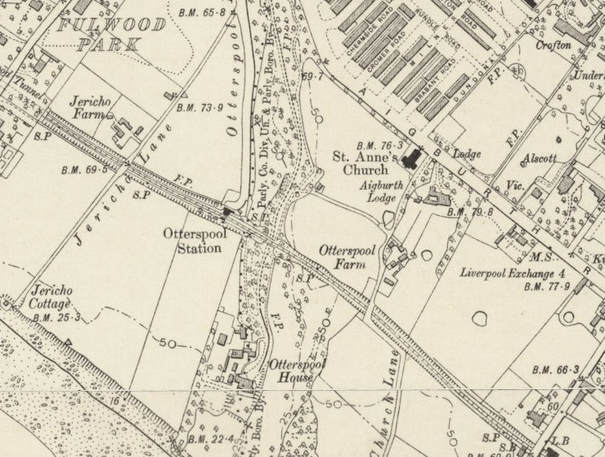 Otterspool Farm, St Anne's, Aigburth, Liverpool
Otterspool Farm, St Anne's, Aigburth, Liverpool
Otterspool Farm, St Anne’s, Aigburth.
The Taylors' business prospered and word spread around the extended family. Jane's brother, Fred Scott, fancied doing the same and he went down to Liverpool. Nothing was available, so he returned north, leaving instructions for Richard to look out for an opportunity. This led to Richard discovering OTTERSPOOL FARM, located behind St Anne’s Church, just a mile further along Aigburth Road from the Church Road dairy. But, Richard took the property for himself. Fred was dismayed and never forgave his brother-in-law, but nevertheless, went on to do well at Cartmel.
The Taylors had relocated to Otterspool Farm by 1920 (Electoral Register). There they returned to a more traditional way of farming — grazing their cattle in fields, but still selling fresh milk locally. Richard was very keen on entering his cows at the local shows, especially at the annual Christmas Show, which by then was under the auspices of the Liverpool and District Livestock Society. He had a number of successes as his appearance in the winners list in local papers bears testimony:
1933 -- Cow, not exceeding 12cwt. Third Prize: R Taylor, Otterspool.
1935 -- Cow, calved, not exceeding 12cwt. Third Prize: R Taylor, Otterspool Farm.
1936 -- Cow not exceeding 12cwt. Third Prize: R Taylor, Otterspool Farm, Aigburth.
1936 — Cow not exceeding 11cwt. First Prize: R Taylor.
1936 — Cow in calf or milk. Second Prize: R Taylor, Aigburth.
1936 — Cow or Heifer in Milk (farmers within 20 mile radius of showground). Third Prize: R Taylor.
1937 -- Cows, calved, not over 10cwt. Second Prize: R Taylor, Otterspool Farm.
The Taylors' business prospered and word spread around the extended family. Jane's brother, Fred Scott, fancied doing the same and he went down to Liverpool. Nothing was available, so he returned north, leaving instructions for Richard to look out for an opportunity. This led to Richard discovering OTTERSPOOL FARM, located behind St Anne’s Church, just a mile further along Aigburth Road from the Church Road dairy. But, Richard took the property for himself. Fred was dismayed and never forgave his brother-in-law, but nevertheless, went on to do well at Cartmel.
The Taylors had relocated to Otterspool Farm by 1920 (Electoral Register). There they returned to a more traditional way of farming — grazing their cattle in fields, but still selling fresh milk locally. Richard was very keen on entering his cows at the local shows, especially at the annual Christmas Show, which by then was under the auspices of the Liverpool and District Livestock Society. He had a number of successes as his appearance in the winners list in local papers bears testimony:
1933 -- Cow, not exceeding 12cwt. Third Prize: R Taylor, Otterspool.
1935 -- Cow, calved, not exceeding 12cwt. Third Prize: R Taylor, Otterspool Farm.
1936 -- Cow not exceeding 12cwt. Third Prize: R Taylor, Otterspool Farm, Aigburth.
1936 — Cow not exceeding 11cwt. First Prize: R Taylor.
1936 — Cow in calf or milk. Second Prize: R Taylor, Aigburth.
1936 — Cow or Heifer in Milk (farmers within 20 mile radius of showground). Third Prize: R Taylor.
1937 -- Cows, calved, not over 10cwt. Second Prize: R Taylor, Otterspool Farm.
In 1937, their son, Eddie, married Mary Henshall at the neighbouring St Annes Church. He moved out of the family home but continued to work at the farm. The three remaining children – Isabel, Margery May and Amy Jane — were also very much involved in the daily routine of the farm. The 1938 directory lists, under ‘Farmers’: Taylor, Rd. Otterspool Farm, St Anne’s, Church Lane, Liverpool 17. That year also saw success for Richard in showing his best cows at the Royal Lancashire Agricultural Show, when it was held at Wavertree Playground. He took first prize with a roan in the Dairy & Fat Cow Class: Dairy cow, calved, any weight. His prize money was £5!
The 1939 Register gives the occupants of Otterspool Farm as follows:
Richard Taylor, married, Farmer Cowkeeper. (d.o.b. 18.02.1874)
Jane Taylor, married, Unpaid Domestic Duties. (d.o.b. 20.04.1876)
Margery May Taylor, single, Unpaid Domestic on Parents' Farm. (d.o.b. 08.11.1904)
Amy Jane Taylor, single, Unpaid Domestic on Parents' Farm. (d.o.b. 12.06.1908)
Isabella Scott, single, Unpaid Domestic Duties. (d.o.b. 11.09.1875)
Also living on the property, in Otterspool Farm Cottage, were Anne L Trainor (Daily Domestic), William D Crosbie (Railway Clerk) and Elizabeth A Crosbie (Unpaid Domestic Duties). Eddie Taylor was living just across Aigburth Road from the farm, at 3 Dundonald Road. He was living with his wife, Mary, and his occupation is described as 'Dairy Farmer (Assisting Father)'.
In 1937, their son, Eddie, married Mary Henshall at the neighbouring St Annes Church. He moved out of the family home but continued to work at the farm. The three remaining children – Isabel, Margery May and Amy Jane — were also very much involved in the daily routine of the farm. The 1938 directory lists, under ‘Farmers’: Taylor, Rd. Otterspool Farm, St Anne’s, Church Lane, Liverpool 17. That year also saw success for Richard in showing his best cows at the Royal Lancashire Agricultural Show, when it was held at Wavertree Playground. He took first prize with a roan in the Dairy & Fat Cow Class: Dairy cow, calved, any weight. His prize money was £5!
The 1939 Register gives the occupants of Otterspool Farm as follows:
Richard Taylor, married, Farmer Cowkeeper. (d.o.b. 18.02.1874)
Jane Taylor, married, Unpaid Domestic Duties. (d.o.b. 20.04.1876)
Margery May Taylor, single, Unpaid Domestic on Parents' Farm. (d.o.b. 08.11.1904)
Amy Jane Taylor, single, Unpaid Domestic on Parents' Farm. (d.o.b. 12.06.1908)
Isabella Scott, single, Unpaid Domestic Duties. (d.o.b. 11.09.1875)
Also living on the property, in Otterspool Farm Cottage, were Anne L Trainor (Daily Domestic), William D Crosbie (Railway Clerk) and Elizabeth A Crosbie (Unpaid Domestic Duties). Eddie Taylor was living just across Aigburth Road from the farm, at 3 Dundonald Road. He was living with his wife, Mary, and his occupation is described as 'Dairy Farmer (Assisting Father)'.
In 1940, there was more marital activity in the family when Isabel married John Andrew Smail. The wedding took place at St Annes Church, located next-door to the farm. With Isabel now married and his regular cowmen being drafted into military service, Richard was prompted to advertise in the local paper (Liverpool Echo) for a “COWMAN – must be good milker. R Taylor. Otterspool Farm, Aigburth”.
Otterspool Farm was in the local papers once more in 1943, but this time the news wasn’t so good. The Liverpool Evening Express of Thursday 1st April reported on a most unfortunate incident: “N.F.S. Fight Farm Blaze — A fire at the farm of Mr. Richard Taylor, Otterspool Farm, Aigburth, Liverpool, last night, destroyed about four tons of hay. The N.F.S. fought the flames for two hours.”
Such setbacks were no deterrent to a farmer like Richard. In 1945 he bounced back and, according to the Liverpool Daily Post of 13th December, “made a great impression with his dairy cows, being awarded the championships for the best pair of cows in calf or milk and for the best shorthorn cow in milk.” Interestingly, many of his showground rivals at that time were also keeping cows in and around Aigburth, including: M I Dugdale of Grassendale Road; R Batty of Aigburth Road; T Hogg of Jericho Lane and Parkfield Road; and also E Harper of Rose Lane in Mossley Hill. Formidable competition, indeed!
When Richard and Jane eventually retired (c. 1947), Eddie took over the running of the business and continued to trade under his father's name. In the post-war era the dairy business increased by leaps and bounds; as well as the milk the cows produced, Eddie also had access to ‘Railway Milk’. As the name suggests, farmers from areas like North Lancashire and the Lake District were sending their milk down to Liverpool via the railways, where the milk was pasteurised and bottled and then sent out to milk retailers like Eddie. His milk round grew and grew. He sold Farm milk from his own cattle, pasteurised, T.T. (Tuberculin Tested,) and sterilised. Eddie did very well out of it, but he deserved everything he got, as the hours were long and seven days a week, with no sick leave.
Eddie continued the family tradition of entering local shows and was included in the winners list in 1952:
- Dairy Cow in calf or milk. Third Prize: E Taylor, Otterspool.
- Dairy Cow in milk, exceeding 10½cwt Second Prize: E Taylor.
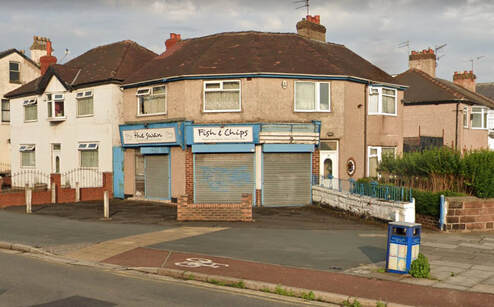 36-38 Woolton Road. (Image capture 2019 ©2020 Google)
36-38 Woolton Road. (Image capture 2019 ©2020 Google)
Despite its success under Eddie's custodianship, the general decline in city milk production eventually caught up with Otterspool Farm. Its demise was announced in a few column inches in the Liverpool Echo of 28th October 1960:
“AIGBURTH SCHOOL – A Start is expected next April on the new building at Otterspool Farm, Aigburth, to accommodate the 540 pupils of St Margaret’s Church of England Commercial Technical School, Anfield.
A three-form entry school, it is expected to take more than two years to complete and may cost in the region of £200,000.”
A month later Eddie delivered a notice to all of his customers informing them of the imminent closure of Otterspool Farm. He also informed them that he would be open for business from his new premises at 36-38 Woolton Road, Garston, commencing 22nd January 1961.
The premises at Woolton Road already had a long history as a dairy, being operated by ‘Master Dairyman’ John Matthew Barber since at least 1939. The dairy had become available due to the previous owner retiring. Eddie ran the dairy for the next ten years or so, until it was time for him too to retire; he and his wife moved to a house at the bottom of Holmfield Road, Aigburth. The building was still fitted out as a dairy, in 1970, when it was acquired by the Hyams family to be the headquarters of Willow Coaches. The shop stands today, on the corner of Woolton Road and Island Road South, and was, most recently, the home of The Swan Fish & Chips.
Richard and Jane moved to Kirkby Lonsdale to enjoy their retirement. Richard passed away in 1961, followed by Jane, in 1963.
Despite its success under Eddie's custodianship, the general decline in city milk production eventually caught up with Otterspool Farm. Its demise was announced in a few column inches in the Liverpool Echo of 28th October 1960:
“AIGBURTH SCHOOL – A Start is expected next April on the new building at Otterspool Farm, Aigburth, to accommodate the 540 pupils of St Margaret’s Church of England Commercial Technical School, Anfield.
A three-form entry school, it is expected to take more than two years to complete and may cost in the region of £200,000.”
A month later Eddie delivered a notice to all of his customers informing them of the imminent closure of Otterspool Farm. He also informed them that he would be open for business from his new premises at 36-38 Woolton Road, Garston, commencing 22nd January 1961.
The premises at Woolton Road already had a long history as a dairy, being operated by ‘Master Dairyman’ John Matthew Barber since at least 1939. The dairy had become available due to the previous owner retiring. Eddie ran the dairy for the next ten years or so, until it was time for him too to retire; he and his wife moved to a house at the bottom of Holmfield Road, Aigburth. The building was still fitted out as a dairy, in 1970, when it was acquired by the Hyams family to be the headquarters of Willow Coaches. The shop stands today, on the corner of Woolton Road and Island Road South, and was, most recently, the home of The Swan Fish & Chips.
Richard and Jane moved to Kirkby Lonsdale to enjoy their retirement. Richard passed away in 1961, followed by Jane, in 1963.
